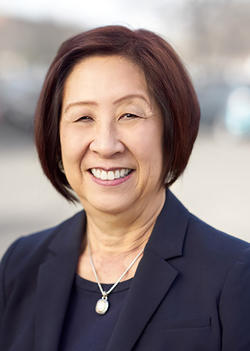Takai served as Department of Defense chief information officer during the Obama administration, where she helped develop a cyber-workforce plan, a mobile device strategy and a 10-point plan for modernizing DoD’s IT enterprise. As a board member for First Net — an independent authority within the U.S. Department of Commerce — Takai helps develop and grow a nationwide broadband network that equips first responders to save lives and protect U.S. communities. And as the executive director of the Center for Digital Government — a national research and advisory institute — she advises on information technology policies and best practices in state and local government.
Takai, who worked for Ford Motor Co. for 30 years in strategic planning and global application development before going into the public sector, said she learned the importance of communications early in her career. And it’s been a key that’s unlocked many successful ventures.
“I’ve always felt it was important to reach out and have a personal conversation with folks,” she said. “The more you can connect with people on a real level — not with jargon — to learn what problems that they are trying to solve, the better success you will have in connecting them with the right technology or strategy to improve their process.”
When speaking with Legacy magazine, Takai shared a few pieces of advice — in addition to striking jargon like digital transformation from your corporate retreat goals — that she’s gleaned over her decades-long tech career.
Protect your assets.
Industrial hackers are not teens sitting at computers in the basement or backroom. That was the case decades ago. But those kids are grown up now and have written very sophisticated software.
These computer programs that are out there constantly trolling the network looking for vulnerability — they don’t distinguish between a big company or a little company when trying to get your data. So educate your employees on what to click on or not click on. Update your passwords regularly. Regularly educate yourself on what security issues are out there and pass them along to your tech users and help them take personal responsibility. Nothing is 100 percent, of course, but these simple things do offer a level of protection.
Talk business first.
When I worked as the CIO for the State of California and for the State of Michigan, I reached out and had conversations with cabinet members, the secretary of state and governmental program directors before developing a technology strategy.
That’s my golden rule: Talk business first. Before you can find an effective solution, you have to be able to understand the business issue. Once you understand, that’s when you come back and suggest where and how technology can make a difference. Don’t go in from a tech perspective and expect folks to agree and apply the technology without understanding the value. The technology needs to work for the business, not the other way around.
Realize that with more technology comes more responsibility.
It’s interesting how the more technological advances we have, the more the information technology role shifts toward helping and guiding people. We are no longer the guys in the backroom; we are front and center.
Get comfortable in that front-facing role. It’s something that isn’t changing. You are a manager, an educator, a leader. You are a resource manager too. For example, now that anyone can buy tech with the click of a button, your job as an information technology leader is to manage the portfolio on who has buying decisions to control the purchases. There are all these facets — it’s exciting really.
Go to conferences and network. See what others in the industry are doing. Take a class to help you better understand business practices or how to communicate effectively. As technology continues to evolve, so will the growing importance and influence that CIOs and other technology leaders have.




